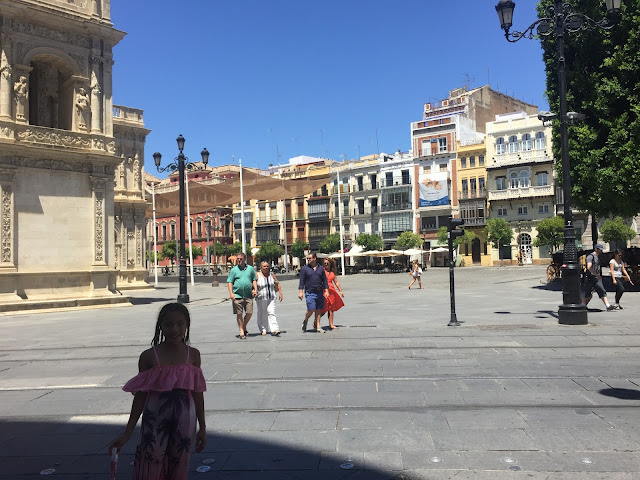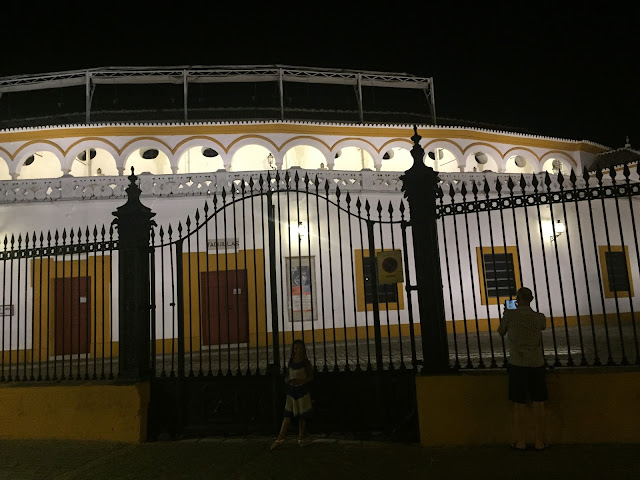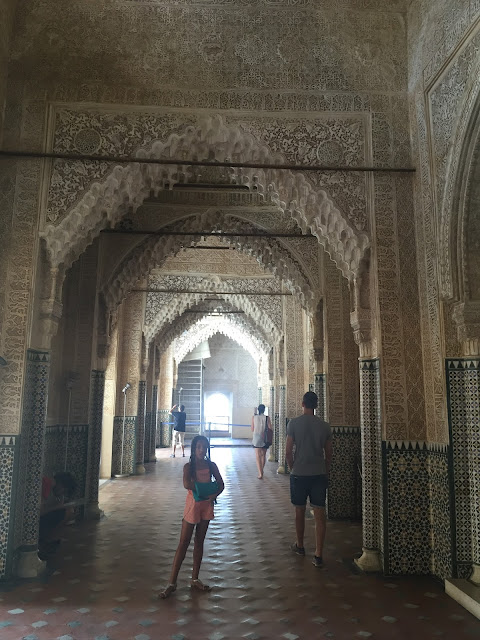The
Andalusian city of Seville and Granada
 |
| Seville |
 |
| Granada |
Andalusia: If this southern region of Spain conjures up images of hot sultry nights, decadent tapas meals, sangria and fine Spanish wine, sexy, passionate, flamenco dancers, beautiful architecture, beautiful people who seem to have discovered and perfected the art of living, and a seamless fusion of Latin, Moorish, Romany, and Jewish influences, that because it is.
Seville and Granada, and
quite possibly the entire Andalusian region may be Spain’s best kept secret. Northern Europeans have long discovered the
Costa del Sol, the strip of coastline that runs from Malaga, all the way to Gibraltar,
and Granada because of its close proximity to Malaga, and home to Spain’s most
visited the monument, the Alhambra.
Seville, however, quite
possibly because of its inland location is usually missing from the itinerary. This
means that travelers who visit Seville have a genuine interest in the city and
all it has to offer. And steep in Spanish tradition, Seville has a lot to
offer, at a reasonable, I will even venture to say very affordable, price. For
anyone wanting to experience authentic Andalusian culture, without the crowds,
Seville and Granada are perfect options.
Getting there: Flying from the U.S to Granada, or Seville will require connections and layovers. Most major airlines will get you there. Prepare for a long flight. Ticket prices vary depending on which part of the country you’re flying from.
Transportation:
Taxis from Seville’s airport to the city center cost between 15-22 euros.
Granada airport to the city center: 25-28euros. There is also a bus that runs
from the airport to Granada’s city center for three euros.
A rental car is a convenient
and efficient way to travel between cities: We flew into Malaga, rented a car
and drove south to Algeciras and Gibraltar before heading slightly northwest to
Seville, and then east to Granada.
Accommodations:
Both cities offer visitors a wide range of accommodations to choose from:
luxury to budget.
Recommendations:
Seville: Hotel Inglaterra is located
in the city center. It overlooks the Plaza Nueva, and is within walking
distance to shops, restaurants, bars, and just about everything you’ll want to
see or do.
 |
| Plaza Nueva |
Granada: Hotel Comfort Dauro 2 is located in Granada’s city center, within walking distance of the Alhambra, and the cathedral.
Things to do
and see:
Seville,
Granada: There are free walking tours, here visitors can
learn about the history of both cities, along with other fun tidbits.
 |
| Seville |
 |
| Seville |
 |
| Granada |
 |
| Granada |
Flamenco show: Andalusia is the cultural birthplace of Flamenco, and Flamenco is performed on the streets of both Seville and Granada. But a visit to the theater, and there are quite a few, is where visitors will experience the true theatrical art that is Flamenco. Brought to Spain by the Roma people, or gypsies, as they’re commonly known, Flamenco is colorful, haunting, passionate, beautiful, and soulful. The passion of the artists is conveyed in both the music and dance. Prices vary based on what’s being offered. Some theaters offer dinner, wine and a show, others wine and a show, or just a show. The prices shown here do not include dinner or drinks.
Recommendation:
Seville: Mueso del Baile Flamenco: a
Flamenco museum dedicated to Flamenco history and culture, with live shows. The museum’s founder is also the premier
female performer. Price adults 18 euros, children 12 euros. The shows are about one hour long, and worth
every cent. The singers and dancers are very passionate, and can become very
emotional.
Granada:
Jardins de Zoraya: Price 18 euros, children under 8 free.
Both places recommended
here offers Flamenco lessons as well.
Places to visit in Seville:
Alcazar of Seville: a
Moorish renaissance palace.
Seville cathedral: the largest gothic cathedral and the third largest church in the world. It dates back to 1507.
Places
to visit in Granada: The Alhambra. Spain’s most visited
monument is a feast for the eyes and a balm to the soul. Rumor has it that the
last Sultan of Granada shed tears at having to part from this serene oasis. Located
on a hilltop overlooking the city of Granada, this sprawling complex of
palaces, gardens, fountains, courtyards etc. dating back to the 1300’s, could
easily take up an entire day. A magical step back in time, where the aesthetics
are unlike anything you’ve ever seen. You’ll travel the path of the Sultan, and
when it’s time to say goodbye, you’ll understand his tears, and sympathize with
his plight.
The complex is accessible
from the city center; a short walk uphill. There is also a shuttle. Driving can
be a bit tricky, since the signs aren’t very clear.
In order to preserve the
buildings, there is a restriction on the number of visitors per day. There are
different types of tickets: morning, afternoon, or evening visit. You can only
access the monument at the time shown on your ticket. And if visiting the
Nasrid Palace inside the complex, you must do so at the hour indicated on your
ticket.
Tickets: Adults 14 euros,
children 12-15 8 euros, children under 12 free. Prices here are for visit to
the entire complex. Tickets to individual parts of the complex can be purchased
at a cheaper price.
Tickets can also be
purchased for guided tours.
When it comes to food,
Spain, with the exception of the Costa del Sol which caters to tourists, always
seems to get it right. Delicious food and wine are guaranteed. My
recommendation: be adventurous, always go for the tapas. It’s a perfect way to
sample lots of different dishes. Most you’ll like, a few, maybe not so much.
But it’s an experience you won’t ever forget.
Both cities are compact.
There are restaurants are everywhere, often times, right outside your hotel,
and they all offer menus in English. On this trip, I took Anthony Bourdain’s
advice: I ate where the Spaniards ate, and was never disappointed. Eating out in Seville is inexpensive when
compared to other Spanish cities, including Granada. So if you’re headed for a foodie vacation,
Seville might be the way to go. Spaniards
are late diners. The cities come alive at night. Dinner can be as late as 10pm.
At midnight you’ll be eating dessert. Plan your day accordingly.
Activities:
After all that eating and drinking a hike through the Sierra Nevada near
Granada might be a good idea. Or not!


























